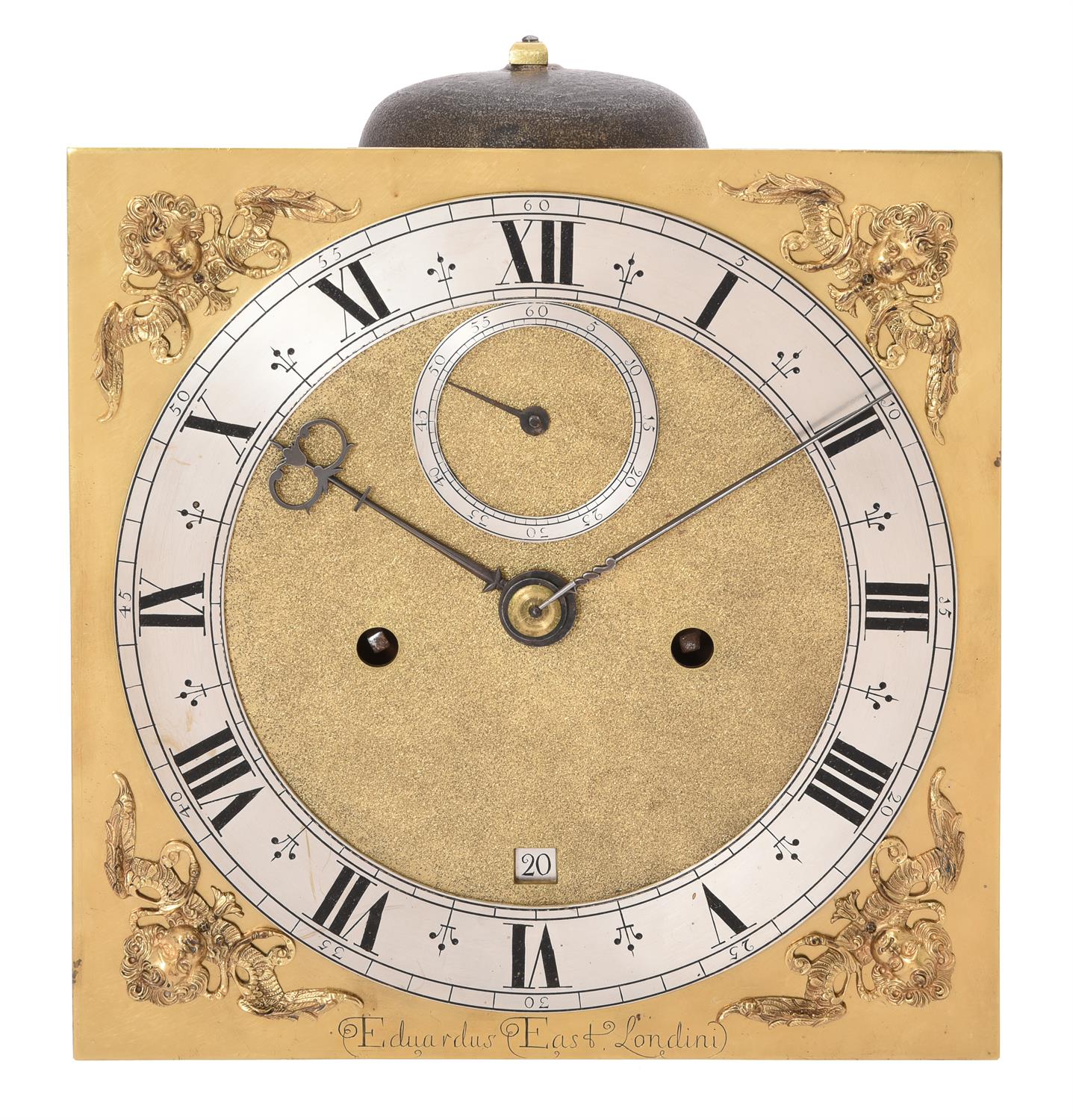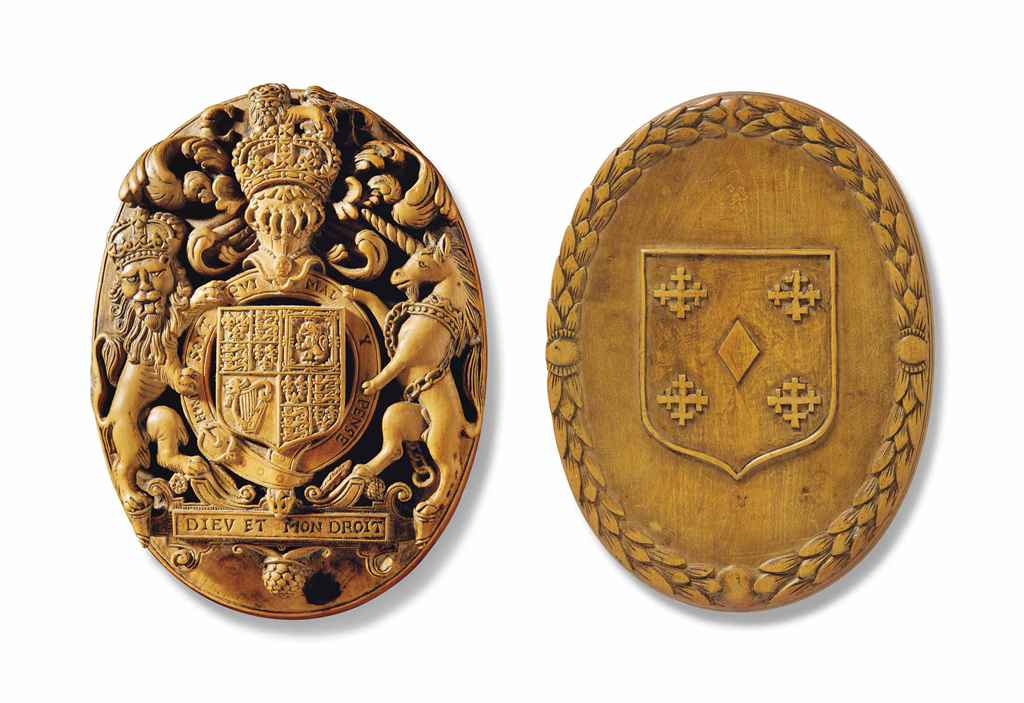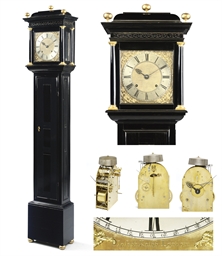Y A FINE CHARLES II/JAMES II EBONY QUARTER-REPEATING TABLE CLOCK OF KNIBB 'PHASE III' TYPE SIGNED FOR HENRY MERRIMAN BUT ATTRIBUTED TO THE WORKSHOP OF JOSEPH KNIBB LONDON, CIRCA 1685-90 The five finned baluster-pillar fully latched twin fusee movement with verge escapement regulated by short bob pendulum incorporating single-footed backcock and steel holdfast hook to the symmetrical scrolling tulip engraved backplate signed Henry Merriman, London in a shallow downward curve across the centre, the strike train and quarter repeat mechanism with both racks positioned against the inside of the backplate and with typical 'Knibb' scroll design sculpted steel feet to the two bell-stands, the 6.25 inch square brass dial with matted centre within applied Roman numeral chapter ring with fleur-de-lys half hour markers and Arabic five minutes within the narrow outer minute track, with fine scroll-pierced steel hands and gilt winged cherub mask spandrels to angles, the upper margin with S/N strike/silent selection and the lower margin further signed in fine tightly executed engraved script Henry Merriman London, the case with later hinged scroll cast brass carrying handle and fruiting vine spray mounts to the domed caddy superstructure now elevated on a later cavetto skirt over caddy top mouldings, the hinged front with glazed dial aperture beneath elongated lozenge aperture to the upper rail now backed with gilt brass panel and applied with vine cast mount matching those to the uprights and lower rail, the sides with conforming lozenge apertures over rectangular windows and vacant slots to the lower front corners, the rear with rectangular glazed door applied with further vine-cast mounts set within the frame of the case, on stepped ogee moulded shallow skirt base now fitted with block feet. 34cm (13,25ins) high with handle down, 24cm (9.5ins) wide, 15cm (6ins) deep. Provenance: The Wrangel Family, Sweden thence by descent. Henry Merryman is recorded in Loomes, Brian Clockmakers of Britain 1286-1700 as born around 1655 and apprenticed in 1667 to Richard Bowen until 1676 although he was made free of the Clockmaker's Company in February 1674/5. He took-in eleven apprentices over the period between April 1676 and December 1703 and in 1695 he is recorded as a 'servant' in working in the parish of St. Catherine Coleman. Henry Merryman signed the Clockmaker's Company oath of allegiance in 1697 however he ceased paying quarterage in 1702. Loomes further notes (under the entry for Thomas Merriman) that a Mr. Merriman received the Clockmaker's Company Charity from 1715 until December 1717; it is not known whether this was Thomas or Henry Merryman. The movement and dial of the current lot can be directly compared (in practically every respect) with an example by Joseph Knibb London illustrated in Garnier, Richard and Carter, Jonathan The Golden Age of English Horology, Masterpieces from The Tom Scott COLLECTION pages 368-69. Both clocks have the same layout and specification as well as the same sized plates (6.75 by 4.75 inches). The location and design of the pillars match as do the latches and the decorated bell-stands. The strike and repeat mechanisms are to the same design utilising racks for each positioned inside the backplate. Both also show evidence (in the form of slots cut into the sides of the case near the front) of having push/pull bars for the quarter repeat mechanisms (a system often used by Knibb but few other makers). In addition to being of the same dimensions the backplates are also engraved with tulip designs that follow the same layout only differing in detail with regards to the alternation of the types of bloom used. It is very clear that both backplates are engraved by the same hand which is no doubt the same individual responsible for the backplate of another almost identical clock by Joseph Knibb illustrated in Dzik, Sunny ENGRAVING ON ENGLISH TABLE CLOCKS, Art on a Canvas of Brass 1660-1800. Other typical 'Knibb' featur
Y A FINE CHARLES II/JAMES II EBONY QUARTER-REPEATING TABLE CLOCK OF KNIBB 'PHASE III' TYPE SIGNED FOR HENRY MERRIMAN BUT ATTRIBUTED TO THE WORKSHOP OF JOSEPH KNIBB LONDON, CIRCA 1685-90 The five finned baluster-pillar fully latched twin fusee movement with verge escapement regulated by short bob pendulum incorporating single-footed backcock and steel holdfast hook to the symmetrical scrolling tulip engraved backplate signed Henry Merriman, London in a shallow downward curve across the centre, the strike train and quarter repeat mechanism with both racks positioned against the inside of the backplate and with typical 'Knibb' scroll design sculpted steel feet to the two bell-stands, the 6.25 inch square brass dial with matted centre within applied Roman numeral chapter ring with fleur-de-lys half hour markers and Arabic five minutes within the narrow outer minute track, with fine scroll-pierced steel hands and gilt winged cherub mask spandrels to angles, the upper margin with S/N strike/silent selection and the lower margin further signed in fine tightly executed engraved script Henry Merriman London, the case with later hinged scroll cast brass carrying handle and fruiting vine spray mounts to the domed caddy superstructure now elevated on a later cavetto skirt over caddy top mouldings, the hinged front with glazed dial aperture beneath elongated lozenge aperture to the upper rail now backed with gilt brass panel and applied with vine cast mount matching those to the uprights and lower rail, the sides with conforming lozenge apertures over rectangular windows and vacant slots to the lower front corners, the rear with rectangular glazed door applied with further vine-cast mounts set within the frame of the case, on stepped ogee moulded shallow skirt base now fitted with block feet. 34cm (13,25ins) high with handle down, 24cm (9.5ins) wide, 15cm (6ins) deep. Provenance: The Wrangel Family, Sweden thence by descent. Henry Merryman is recorded in Loomes, Brian Clockmakers of Britain 1286-1700 as born around 1655 and apprenticed in 1667 to Richard Bowen until 1676 although he was made free of the Clockmaker's Company in February 1674/5. He took-in eleven apprentices over the period between April 1676 and December 1703 and in 1695 he is recorded as a 'servant' in working in the parish of St. Catherine Coleman. Henry Merryman signed the Clockmaker's Company oath of allegiance in 1697 however he ceased paying quarterage in 1702. Loomes further notes (under the entry for Thomas Merriman) that a Mr. Merriman received the Clockmaker's Company Charity from 1715 until December 1717; it is not known whether this was Thomas or Henry Merryman. The movement and dial of the current lot can be directly compared (in practically every respect) with an example by Joseph Knibb London illustrated in Garnier, Richard and Carter, Jonathan The Golden Age of English Horology, Masterpieces from The Tom Scott COLLECTION pages 368-69. Both clocks have the same layout and specification as well as the same sized plates (6.75 by 4.75 inches). The location and design of the pillars match as do the latches and the decorated bell-stands. The strike and repeat mechanisms are to the same design utilising racks for each positioned inside the backplate. Both also show evidence (in the form of slots cut into the sides of the case near the front) of having push/pull bars for the quarter repeat mechanisms (a system often used by Knibb but few other makers). In addition to being of the same dimensions the backplates are also engraved with tulip designs that follow the same layout only differing in detail with regards to the alternation of the types of bloom used. It is very clear that both backplates are engraved by the same hand which is no doubt the same individual responsible for the backplate of another almost identical clock by Joseph Knibb illustrated in Dzik, Sunny ENGRAVING ON ENGLISH TABLE CLOCKS, Art on a Canvas of Brass 1660-1800. Other typical 'Knibb' featur















Testen Sie LotSearch und seine Premium-Features 7 Tage - ohne Kosten!
Lassen Sie sich automatisch über neue Objekte in kommenden Auktionen benachrichtigen.
Suchauftrag anlegen